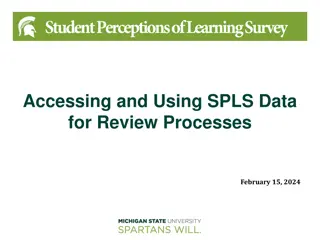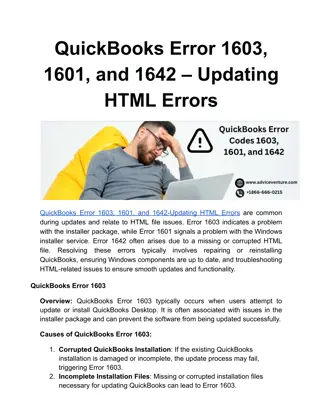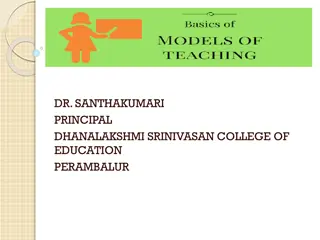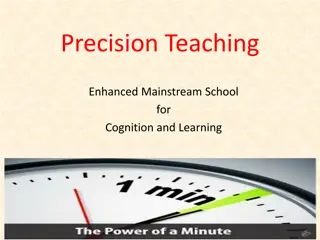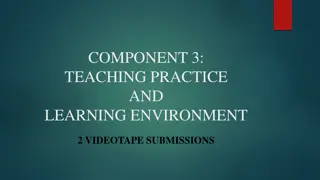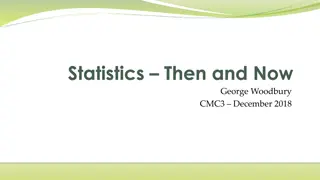
Cost-Volume-Profit Analysis in Managerial Accounting
Explore the essential concepts of Cost-Volume-Profit (CVP) analysis in managerial accounting, including Contribution Margin, Break-Even Point, and Decision-Making. Learn about the assumptions in CVP analysis and how it influences business decisions. Dive into the Contribution Income Statement and grasp the significance of Contribution Margin in covering fixed expenses and generating profits.
Download Presentation

Please find below an Image/Link to download the presentation.
The content on the website is provided AS IS for your information and personal use only. It may not be sold, licensed, or shared on other websites without obtaining consent from the author. If you encounter any issues during the download, it is possible that the publisher has removed the file from their server.
You are allowed to download the files provided on this website for personal or commercial use, subject to the condition that they are used lawfully. All files are the property of their respective owners.
The content on the website is provided AS IS for your information and personal use only. It may not be sold, licensed, or shared on other websites without obtaining consent from the author.
E N D
Presentation Transcript
First lecture Managerial Accounting Supervisor pro. Dr. Rzgar By Hemn Mohammed Aziz
Cost Volume Profit (CVP) Relationships Contribution Margin (CM) Contribution Margin Ratio CVP CVP Formula Break Even Point Target Profit Analysis The Margin of Safety 2
Cost-volume-profit (CVP) analysis It isa powerful tool that helps managers understand the relationships among cost, volume, and profit. CVP analysis focuses on how profits are affected by the following five factors: 1. Selling prices. 2. Sales volume. 3. Unit variable costs. 4. Total fixed costs. 5. Mix of products sold. 3
Cost-volume-profit (CVP) analysis it is a vital tool in many business decisions. These decisions include: what products and services to offer. what prices to charge. what marketing strategy to use, and what cost structure to implement 4
Assumptions in cost-volume-profit analysis CVP analysis relies on several assumptions: 1. Cost can be classified as variable and fixed. 2. Cost are linear within the relevant range. 3. All units produced are sold. ( inventory levels do not change) ( unit produced = unit sold) 4. Sales mix is constant. If cost and sales differ from these assumptions, the results of CVP analysis can be less useful. 5
Contribution Margin Contribution margin is the amount remaining from sales revenue after variable expenses have been deducted. Thus, it is the amount available to cover fixed expenses and then to provide profits for the period. Contribution Margin = Total Sales Variable Costs CM per Unit = Selling Price Variable Cost per unit 6
Contribution Income Statement The contribution income statement has been prepared for management s use inside the company and would not ordinarily be made available to those outside the company. 7
Contribution Income Statement Contribution margin is used first to cover the fixed expenses, and then whatever remains goes toward profits. If the contribution margin is not sufficient to cover the fixed expenses, then a loss occurs for the period. To illustrate with an extreme example, assume that a company sells only one unit of product during a particular month. The company s income statement would appear as follows: 8
Contribution Income Statement If enough speakers can be sold to generate $35,000 in contribution margin, then all of the fixed expenses will be covered and the company will break even for the month that is, it will show neither profit nor loss but just cover all of its costs. The company s income statement would appear as follows: 9
Break Even Point The break-even point is the level of sales at which profit is zero. Once the break-even point has been reached, net operating income will increase by the amount of the unit contribution margin for each additional unit sold. For example, if 351 Units are sold in a month, then the net operating income for the month will be $100 because the company will have sold 1 Unit more than the number needed to break even: 10
CVP Relationships in Equation Form Profit = (Sales - Variable Cost) - Fixed Cost When a company has only a single product we can further refine the equation as follows: Sales = Selling price Quantity sold = P Q Variable Cost = Variable Cost per Unit Quantity sold = V Q Profit = (P Q - V Q) - Fixed Costs 11
For example, the net operating income (profit) at sales of 351 units would be $100. We can arrive at the same conclusion using the above equation as follows: Profit = (P Q - V Q) - Fixed Costs Profit = ($250 351 - $150 351) - $35,000 = ($250 - $150) 351 - $35,000 = ($100) 351 - $35,000 = $35,100 - $35,000 = $100 Note: (P V) Q = Unit CM Q = $ 100 12
It is often useful to express the simple profit equation in terms of the unit contribution margin (Unit CM) as follows: Unit CM = Selling price per unit - Variable cost per unit = P - V Profit = (P Q - V Q) - Fixed cost Profit = (P - V) Q - Fixed cost Profit = Unit CM Q - Fixed cost 13
CVP Relationships in Graphic Form The relationships among revenue, cost, profit, and volume are illustrated on a cost-volume-profit (CVP) graph. A CVP graph highlights CVP relationships over wide ranges of activity. 14
CVP Relationships in Graphic Form 1. Fixed Costs 15
The Profit Graph Consider the previous example, when level of sales was 350 Units = break even point When Sales is above 350 units would generate PROFIT. However, sales below 350 units, the company have LOSS. 17
Contribution Margin Ratio The contribution margin ratio also can be used in cost- volume-profit calculations. Selling Price Variable Cost Selling Price CM ratio = 18
Contribution Margin Ratio Selling Price Variable Cost Selling Price CM ratio = CM ratio = Total contribution margin / Total sales = $40,000 / $100,000 = 40% OR CM ratio = Unit Contribution margin / Unit Selling price = $100 / $250 = 40% or 0.4 19
Break-Even Analysis Break-even analysis can be approached in two ways: 1. Equation method The equation method is based on the contribution approach of income statement. Profit = (Unit CM) Q - Fixed expenses Profit = Sales (variable costs + Fixed costs) Sales = variable costs + Fixed costs + Profit* *At Break even point Profit equal Zero 20
2. Contribution margin method. Fixed cost BEP = selling price Variable cost per unit F.C BEP= CM 21
1. Equation Method Here is financial information from a Bicycle producer Co. Required: 1. Calculate break even point using equation method 22 2. Calculate break even point using CM. method
Break even point in UNITS SOLD Sales = Variable costs + Fixed costs + Profits $500 Q = $300 Q + $80,000 +$0 Where: Q = Number of bikes sold $500 Q = $300 Q + $80,000 + $0 $200 Q = $80,000 Q = 400 bikes 23
Proof Total Per unit Percent Sales (400 bikes) 200000 500 100% Less: variable cost (400 bikes) Contribution margin (400 bikes) Less: fixed cost 120000 80000 80000 300 200 60% 40% Net income before tax 0 24
Break even point in Sales Dollars Solution 1 Sales = Variable expenses + Fixed expenses + Profits X = 0.60 X + $80,000 + $0 Where: X = Total sales dollars 0.60 = Variable expenses as a percentage of sales X = 0.60 X + $80,000 + $0 0.40 X = $80,000 X = $200,000 25
Or BEP in Dollars= Unit sales to break even SP = 400 unit * 500= $200000 26
Solution required 2 80000 BEP IN UNIT= = 400 Unit 200 80000 BEP IN UNIT= = $200000 0.4 28
Example 1 Concerning The Coffee-shop of Salahading University; The selling price of a cup of coffee is $1.5. The variable cost per cup is $0.36. The fixed cost per month is $1,710. 2,100 cups are sold each month on average. 1. Calculate CM and CM%? 2. Calculate break-even sales in units and sales in dollars? 29
Solution required CM= P-V = 1.5 0.36 = $1.14 CM% = CM/ P= 1.14/1.5= 0.76 OR 76% 1710 BEP IN UNIT= = 1500 Unit 1.14 1710 BEP IN UNIT= = $2250 0.76 30
Target Profit Analysis Target profit analysis and break-even analysis are used to answer questions such as how much would we have to sell to make a profit of $10,000 per month or how much would we have to sell to avoid incurring a loss? There are two methods to do so: 1. The Equation Method 2. The Formula Method 31
1. Equation Method Here is financial information from a Bicycle producer Co. 32
1. Equation Method Suppose the bicycle Co. wants to know how many bikes must be sold to earn a profit of $100,000. Solution: Sales = Variable expenses + Fixed expenses + Profits $500Q = $300Q + $80,000 + $100,000 $200Q = $180,000 Q = 900 bikes 33
2. Contribution Margin Method Suppose the bicycle Co. wants to know how many bikes must be 1. sold to earn a profit of $100,000. 2. Dollar sales to attain the target profit. Solution: = $80,000 + $100,000 / $200 = 900 bikes 34
Dollar sales to attain the target profit = 100000+80000/0.4= $450000 35
The Margin of Safety The margin of safety is the excess of budgeted (or actual) sales dollars over the breakeven volume of sales dollars. It is the amount by which sales can drop before losses are incurred. The higher the margin of safety, the lower the risk of not breaking even and incurring a loss. The formula for the margin of safety is: Margin of safety (in units) = actual sales quantity - Breakeven quantity Margin of safety = Total actual sales - Break-even sales 36
Example The company of bicycles has the following information 1. Calculate the margin of safety 2. Calculate the margin of safety percentage 37
Example: The following data were extracted from the income statement of an industrial company Details Amount Percentage Sales 200,000 ? ( Variable cost (150,000 ? Contribution margin 50,000 ? Fixed cost (40,000) Net income 10,000 Required: Calculate the margin of safety percentage 38
Solution : 200000-150000 CM%= = 0.25 200000 BEP in dollar= 40000/0.25= 160000 Margin of safety in dollars=200000-160000 = $40000 Margin of safety percentage= 40000/200000*100=20%
Target net income and income tax 1. Target operating income. 2. Target net income. 1. Target operating income: quantity of units Fixed costs + Target operating income required to be sold = Contribution margin per unit Revenues needed to earn Fixed costs + Target operating income target operating income = Contributionmargin percentage 40
Example: Selling price is $200, variable cost per unit is $120, fixed costs are $2,000, and target operating income is $1,200 Required: What is the target sales volume to achieve the planned profit? quantity of units Fixed costs + Target operating income required to be sold = Contribution margin per unit 2000+1200/ 80 = 40 unit 41
Revenues needed to earn Fixed costs + Target operating income target operating income = Contribution margin percentage 2000+1200/ 0.4 = $8000 42
Target net income and income tax Net income is operating income plus nonoperating revenues (such as interest revenue) minus nonoperating costs (such as interest expensive) minus income taxes. For simplicity, throughout this chapter we assume nonoperating revenues and nonoperating costs are zero. So, our net income equation will simply be: Net income = Operating income - Income taxes Target net income Target operating income = 1 - Tax rate 43
Example: A modern company produces a keyboard for computers. Below are the details for that product. Selling price $10, variable cost per unit $6, fixed cost $100,000, net income $45000, income tax rate 25%. Target net income Target operating income = 1 - Tax rate = 45000/1-0.25 =60000 44
quantity of units Fixed costs + Target operating income required to be sold = Contribution margin per unit 100,000+60,000/ 4= 40000unit 45
Using CVP Analysis for Decision Making 1. Decision to advertise 2. Decision to reduce the selling price. 3. Determining target price. 46
1. Decision to advertise Suppose Emma anticipates selling 40 units of the GMAT Success package at the fair. indicates that Emma s operating income will be $1,200. Emma is considering advertising the product and its features in the fair brochure. The advertisement will be a fixed cost of $500. Emma thinks that advertising will increase sales by 10% to 44 packages. Should Emma advertise? The following table presents the CVP analysis. 47
2. Decision to reduce the selling price. Emma is contemplating whether to reduce the selling price from $200 to $175. At this price, she thinks she will sell 50 units. At this quantity, the test-prep package company that supplies GMAT Success will sell the packages to Emma for $115 per unit instead of $120. Should Emma reduce the selling price? 49
3,000 $ CM from lowering price to $175: ($175 - $115) per unit 50 units 3,200 CM from maintaining price at $200: ($200 - $120) per unit 40 units ) 200 ( $ Change in contribution margin from lowering price Decreasing the price will reduce contribution margin by $200 and, because the fixed costs of $2,000 will not change, will also reduce Emma s operating income by $200. Emma should not reduce the selling price Note: Operating income can be prepared 50


